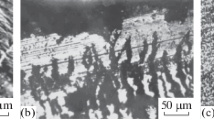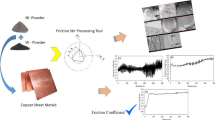In the present work, mechanical and tribological investigations of samples based on Cu–Fe system with different amounts of austenitic steel in the copper matrix have been carried out. By the method of electron-beam wire additive technology, samples of metal matrix composites have been obtained from heterogeneous materials with introduction at printing of 10, 25, 36 and 50% of steel 321 in the matrix of copper C11000. In the work, essential orientation dependence of mechanical and tribological behavior of samples is established. For samples the friction plane of which was located longitudinal to layers, fast growth of wear intensity at increase in the content of copper has been revealed. It occurs due to the lesser role of friction adhesion and plastic displacement of the sample material from the friction contact zone. It is revealed that at increase of the volume fraction of steel introduced into the copper matrix, there is a limit in hardening of composite material. At introduction of more than 25% of steel, the mechanical properties of the material change sufficiently weakly. Changes of the mechanical properties of materials at increase of the steel content up to 50% consist in essential growth of plasticity. At tribological tests, the essential decrease in average coefficient of friction and wear is revealed at samples with steel content of 50%, the friction plane of which has been located transvese to the applied layers. For all samples, the wear resistance was higher than that of additive samples of pure copper.
Similar content being viewed by others
References
J. Matejicek and S. Sampath, Acta Mater., 51, 863–872 (2003).
Y. Chen, B. Xu, Y. Liu, et al, Trans. Nonferrous Met. Soc. China, 18, 603–609 (2008).
T. Watanabe, T. Sato, and A. Nezu, Thin Solid Films, 407, 98–103 (2002).
G. Jandin, H. Liao, Z. Q. Feng, et al., Mater. Sci. Eng. A, 349, 298–305 (2003).
H. L. Liao, Y. L. Zhu, R. Bolot, et al., Surf. Coat. Technol., 200, 2123–2130 (2005).
M. R. Hirsch and R. W. Neu, Tribol. Int., 68, 77–84 (2013).
J. J. Madge, S. B. Leen, I. R. McColl, et al., Wear, 262, 1159–1170 (2007).
O. Jin and S. Mall, Int. J. Fatigue, 24, 1243–1253 (2002).
L. Wei, Y. S. Choy, C. S. Cheung, et al., Wear, 448–449, 203215 (2020).
W. Österle, C. Prietzel, H.Kloß, et al., Tribol. Int., 43, 2317–2326 (2010).
B. Zheng, J. Wang, Y. Gu, et al., Eng. Struct., 231, 111778 (2021).
T. DebRoy, H.Wei, J. Zuback, et al., Prog. Mater. Sci., 92, 112–224 (2018).
H. Ding, Y. Xiao, Y. Wu, et al., J. Alloys Compd., 885, 160949 (2021).
J. Chen, Y. Yang, C. Song, et al., Mater. Sci. Eng. A., 792, 139316 (2020).
J. Xu, Y. Peng, Q. Zhou, et al., Mater. Sci. Eng. A., 798, 140232 (2020).
A. V. Gusarova, A. V. Chumaevskii, K. S. Osipovich, et al., Nanosci. Technol., 11, 195–205 (2020).
X. Shu, G. Chen, J. Liu, et al., Mater. Lett., 213, 374–377 (2018).
E. G. Astafurova, S. V. Astafurov, K. A. Reunova, et al., Phys. Mesomech., 25, 1–11 (2022).
K. S. Osipovich, E. G. Astafurova, A. V. Chumaevskii, et al, J. Mater. Sci., 55, 9258–9272 (2020).
Author information
Authors and Affiliations
Corresponding author
Rights and permissions
Springer Nature or its licensor (e.g. a society or other partner) holds exclusive rights to this article under a publishing agreement with the author(s) or other rightsholder(s); author self-archiving of the accepted manuscript version of this article is solely governed by the terms of such publishing agreement and applicable law.
About this article
Cite this article
Osipovich, K.S., Knyazhev, E.O., Chumaevskii, A.V. et al. Influence of Friction Surface Direction of the Heterogeneous Composites Based on Cu-Fe for Tribological and Mechanical Behavior. Russ Phys J 65, 1404–1410 (2022). https://doi.org/10.1007/s11182-023-02783-w
Received:
Published:
Issue Date:
DOI: https://doi.org/10.1007/s11182-023-02783-w




